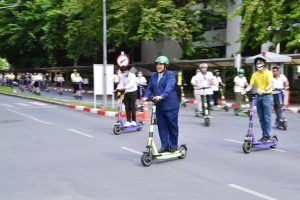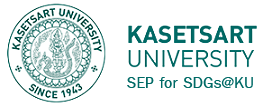
Universities Responsibilities
GOALS
1. To continuously pursue high quality research, creative works, and innovation which receive international recognition, and support initiatives that will improve the development of targeted industries in Thailand, such as agriculture, food, forestry, fisheries, and veterinary science.
2. To provide academic programs and produce graduate who meet rigorous international standards, and to build a wide base of citizen participation in sustainable national development.
3. To contribute meaningfully to a multicultural, knowledge-based society and to promote the philosophy of sufficiency economy by giving people access to educational opportunities leading to the acquisition of knowledge in a variety of forms.

Strategies
Strategy 1 : To promote and expand Knowledge of the Land that encourages national sustainable development in all sectors of society.
Strategy 2 : To continuously develop and improve on academic programs that are recognized internationally for educational and research excellence.
Strategy 3 : To ensure high quality, operational efficiencies that will achieve of the universities' mission and goals.
Strategy 4 : To apply principles of good governance that ensure sustainable management of the universities' resources, people and assets.
Strategy 5 : To continuously improve the universities' administrative skills and competencies, and to ensure effective management by embracing technology changes.
POLICY @SDGs
Kasetsart University is the first higher education institution in Thailand. It Grows up and develops into a university is “Knowledge of the Land.” which is integrity and sustainable, thereby linking with agriculture, which is a basic science of the university, besides, induce the King’s science, community science, and international science, which integrated to create academic lead to being a leading university to develop the country sustainably and has an internationally recognized reputation.
Kasetsart University acknowledged the pressing issue of the climate crisis. On March 2, 2023, Dr. Jongrak Watcharinrat, the President of Kasetsart University, announced at the 61st academic conference, ” KASETSART for AIl: Expanding Knowledge of the Land towards Sustainable Well-being,” the institution’s endorsement of the “KU Goes Green and Carbon Neutrality” policy. This initiative is in alignment with the country’s goals to tackle the climate crisis and achieve the Sustainable Development Goals (SDGs). Building on its reputation as a Green University, Kasetsart aims for complete carbon neutrality by 2035, coinciding with the 80th anniversary of its establishment.
Kasetsart University has laid out its policy and objectives to achieve carbon neutrality by 2035. This includes a strategic plan focusing on:
Energy Dimension : Enhancing energy efficiency in buildings, adopting renewable energy sources such as solar roofs and wind farms, and promoting the use of electric vehicles on campus to minimize greenhouse gas emissions.
Forest and Green Space Dimension: Evaluating the carbon sequestration potential of the forests and green spaces across its 5 campuses and 26 research stations, spanning roughly 13,000 acres. The goal is to enhance the region’s capability to absorb carbon dioxide.
Agricultural Dimension: Encouraging precision agriculture, efficient fertilizer application, abandoning crop burning, promoting alternate wetting and drying rice cultivation techniques, sustainable farming practices, repurposing agricultural waste, and developing low-carbon agricultural products.
Waste and Wastewater Management Dimension: Reducing waste generation, separating waste for recycling in line with the circular economy concept, decreasing wastewater generation, and improving wastewater treatment technologies.
This initiative seeks to position Kasetsart University as a pioneer in carbon neutrality, serving as a model for societal learning. Previously, the university organized the “Carbon Neutral Kaset Fair” to measure the carbon emissions from the agriculture fair activities. This was overseen by the Faculty of Environmental Science at Kasetsart University in collaboration with 75 student volunteers. Subsequently, they compensated for the carbon emissions by purchasing carbon credits registered with TGO. Objective
Environmental development policy objectives for sustainability Kasetsart University are as follows:
- Building cooperation between personnel and students in the university to promote learning and create a sustainable, environmentally friendly working environment.
- Raise awareness about environmental issues affecting communities and work with communities to fix these problems through teaching activities, research, and academic services.
- Encourage students to participate in sustainable development projects to create knowledge by effort as part of learning.
- Participation of local communities in the care of natural resources and using local resources, therefore the purpose of infrastructure construction.
- Commitment to sustainable land management through agroforestry by demonstrating the prototype to the community and society.
- Protection, monitoring, and conservation of campus flora and fauna and conservation of natural habitats with identifying the invasive species, therefore reducing the impact on local flora and fauna.
- Clean and affordable energy management to reduce global warming.
- Promote persistence in biodiversity by maintaining the natural environment by conserving, restoring, and solving soil and water resources in universities and communities.
- Management of waste generated on campus through proper disposal and treatment.
- Marine pollution management conserves and sustainably utilizes the oceans, seas, and marine resources for sustainable development from the personnel’s knowledge.
- Planning of structures and architectures that take into account the environment and biodiversity
Responsible Units
The university has the primary responsibility for implementing this policy through
A sustainable development working group, Kasetsart University
- An energy management committee, Kasetsart University
- UI green data collection working group, Kasetsart University, and
- Working group driving world university rankings, Kasetsart University.
The dean, director of the bureau/institution, and agency are responsible for implementing the University’s environmental policy within the scope of governance.
At the same time, all personnel and students of Kasetsart University have a vital role in helping to conserve the environment and achieve the United Nations Sustainable Development Goals.
OUR University
 The establishment of Kasetsart University was part of the evolution of agricultural education in the country which began with the founding of a system of technical schools. This era may be divided into three periods.
The establishment of Kasetsart University was part of the evolution of agricultural education in the country which began with the founding of a system of technical schools. This era may be divided into three periods.
In the initial period (1904-1913), agricultural education was first established. In 1904, Prince Phichaimahintharodom, Director of the Department of Sericulture of the Ministry of Agriculture, founded the School of Sericulture in Tambon Thung Saladaeng, Bangkok, adjacent to the mulberry gardens and the Sericulture Experimental Station. Initially, the School offered a two-year program devoted to sericulture alone, but in 1906, the program was extended to three years and expanded to include instruction on the cultivation of other crops and also on veterinary science, and at the same time, the name of the institution was changed to the School of Agriculture.
 In 1908, the Ministry of Agriculture merged the three schools under its jurisdiction, namely, the School of Surveying, which had been founded in 1882, the School of Irrigation, founded in 1905, and the School of Agriculture, in order to train personnel to serve in the various departments and divisions of the Ministry. The school was named the School of the Ministry of Agriculture and was located in the Sapathum Palace. At the same time, a new curriculum, Thailand’s first tertiary-level agriculture curriculum, was drawn up and was inaugurated in 1909.
In 1908, the Ministry of Agriculture merged the three schools under its jurisdiction, namely, the School of Surveying, which had been founded in 1882, the School of Irrigation, founded in 1905, and the School of Agriculture, in order to train personnel to serve in the various departments and divisions of the Ministry. The school was named the School of the Ministry of Agriculture and was located in the Sapathum Palace. At the same time, a new curriculum, Thailand’s first tertiary-level agriculture curriculum, was drawn up and was inaugurated in 1909.
In 1913, the Government of Siam merged the School of the Ministry of Agriculture with the Civil Service School, which was established under the Ministry of Public Instruction and Religion, because the purposes of the two were identical. Agricultural education was thus placed under the Ministry of Public Instruction and Religion.
In the middle period (1914-1923), the first primary school agriculture teacher training school was established. The Minister of Public Instruction and Religion, Chao Phraya Thammasakmontri (Sanan Thep-hatsadin na Ayutthaya), founded the Primary School Agriculture Teacher Training School at Ban Suan Luang in Bangkok. The School offered a two-year program for graduates of Secondary Level 3 (the entrance requirement was later raised to Secondary Level 6). Upon completion of the program, graduates were awarded a certificate in primary school agricultural education. In 1918, the School was relocated to Tambon Phra Prathon in the Meuang District of Nakhorn Pathom Province.
In the later period (1924-1942), the primary school agriculture teacher training school system was established in all regions of the country. In 1924, the Primary School Agriculture Teacher Training School was moved from Nakhorn Pathom Province to Tambon Bang Saphan Yai in Bang Saphan District of Prajuab Khirikhan Province, and in 1926, a second primary school agriculture teacher training school was established in Tambon Thap Kwang in Kaeng Khoi District of Saraburi Province. Following this, agricultural education on the primary and secondary levels was provided through primary- and secondary-level agriculture technical schools.
Toward the end of the year 1931, Mom Chao Sitthiphorn Kritdakorn, Director of the Agricultural Research Department of the Ministry of Agriculture, proposed that agricultural research stations be set up in the Northeastern, Southern, and Northern Regions together with primary school agriculture teacher training schools so that agricultural research and agricultural education could be carried out in concert. As a result, primary school agriculture teacher training schools and agricultural experiment stations were established in each region of the country, and in this way, the Ministry of Agriculture once again became involved in agricultural education.

In 1933, the Non Wat Primary School Agriculture Teacher Training School was established in Tambon Non Sung, Non Sung District, Nakhorn Ratchasima Province, and the Mae Jo Primary School Agriculture Teacher Training School was established in Tambon Nong Han, Sansai District, Chiang Mai Province.
In 1934, the Khor Hong Primary School Agriculture Teacher Training School was established in Tambon Khor Hong, Hat Yai District, Songkhla Province.
The operating of agricultural experiment stations in conjunction with the three primary school agriculture teacher training schools proved to be an excellent model of the interplay between research and education. The first experiment-station-head-cum-headmasters were Luang Ingkhasikasikan at Non Wat, Luang Suwan Vajokkasikij at Khor Hong, and Phra Chuangkasetsinlapakan at Mae Jo.
In 1935, agricultural education policy changed once again. The government, concerned that the numbers of agriculture teachers graduated would be in excess of needs, decided to close the three new primary school agriculture teacher training schools. In response, Luang Ingkhasikasikan, Luang Suwan Vajokkasikij, and Phra Chuangkasetsinlapakan together proposed a project whereby the Mae Jo school was retained as a secondary-level agriculture technical school. This was later elevated to become the College of Agriculture, with the status of a division in the Department of Agriculture and Fisheries. The person appointed to serve as the first director of the College was Phra Chuangkasetsinlapakan.
Also in 1935, the Ministry of Agriculture established in Phrae Province another technical school, namely the School of Forestry, which offered a two-year program, and shortly later, this was made a part of the College of Agriculture.
In 1938, the Ministry of Agriculture established the Central Agriculture Station, or Kaset Klang, in Bang Khen District of Bangkok, the area in which the main campus of Kasetsart University is located. The College of Agriculture was moved from Mae Jo to Bang Khen, and Luang Suwan Vajokkasikij became the director. The College offered three-year certificate programs in three fields: agriculture, cooperative science, and forestry. Students of the agriculture program studied all three years at Bang Khen, while students of the cooperative science program studied their first two years at Bang Khen and their third year at the Department of Cooperatives at Tha Thian in order to facilitate their practical training. The forestry program was conducted at the School of Forestry in Phrae Province.
WHO WORK WITH US

